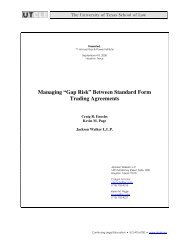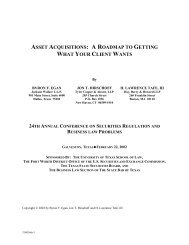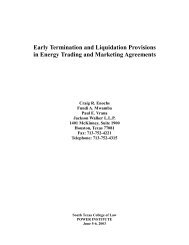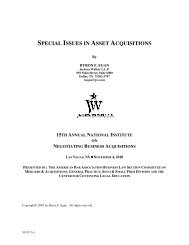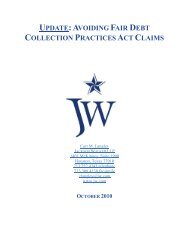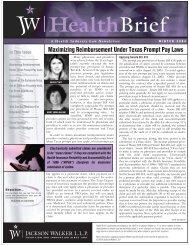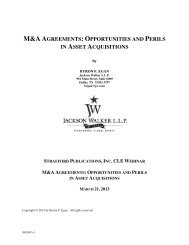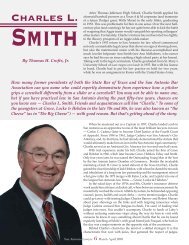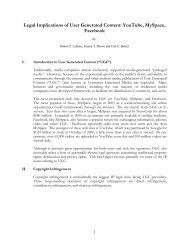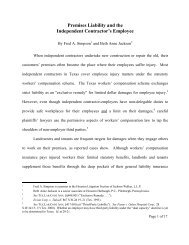busted m&a deals headed for litigation - Jackson Walker LLP
busted m&a deals headed for litigation - Jackson Walker LLP
busted m&a deals headed for litigation - Jackson Walker LLP
You also want an ePaper? Increase the reach of your titles
YUMPU automatically turns print PDFs into web optimized ePapers that Google loves.
could be described generally, identified specifically or described using some combination of<br />
the two. Whichever method of description is used, it is important that the method chosen be<br />
consistent with the description of the acquired assets.<br />
In general, the Model Agreement uses general descriptions to categorize the<br />
Excluded Assets. One of these descriptions, Sections 2.2(e), is qualified by reference to the<br />
Assets to reflect the fact that, in general, this category of assets is being retained by the Seller<br />
but selected assets are being acquired by the Buyer. Two other sections, Sections 2.2(d) and<br />
2.2(f), reflect the opposite approach. Each category of assets described in these sections is<br />
being acquired by the Buyer and only selected assets are being retained by the Seller.<br />
However, through Part 2.2(k), the Model Agreement also provides <strong>for</strong> the specific<br />
identification of certain assets to be retained by the Seller which do not fit within a general<br />
category and do not merit a special category or identification in the text of the Agreement.<br />
The description of excluded assets needs also to mesh with the description of the<br />
assumed and excluded liabilities. For example, Section 2.2(i) of the Model Agreement<br />
provides that the Seller will retain all rights and assets relating to the Employee Plans.<br />
Correspondingly, Section 2.4(b)(vi) of the Model Agreement provides that the Seller retains<br />
all liabilities relating to those Employee Plans.<br />
A number of the categories are designated as excluded assets because the Seller will<br />
continue as an independent company after the closing of the transactions contemplated by the<br />
Model Agreement. The Seller should retain all of its rights under the Model Agreement and<br />
related documents. Also in this category are the Seller’s minute books, stock records and<br />
corporate seal, all of which are properly retained by the Seller in an asset purchase, and<br />
personnel records and other records the Seller is legally required to retain. However, the<br />
Buyer may want to ensure that it has access to these retained items and the ability to make<br />
copies to address post-closing matters. The Buyer should also specify where this inspection<br />
will occur as the Seller may liquidate and move the records to an inconvenient location.<br />
Finally, the Buyer may want the right to obtain these items if the Seller ever decides to<br />
discard them. The Model Agreement provides that the Buyer will receive a copy of certain<br />
of these items in Section 2.1(g). See Section 10.10 and accompanying Commentary.<br />
Section 2.2(a) reflects the norm in asset purchase transactions that the buyer<br />
typically will not buy cash and cash equivalents. There usually is no reason to buy cash<br />
because this simply would have a dollar <strong>for</strong> dollar impact on the purchase price and<br />
excluding cash provides logistical simplicity. However, there may be situations when the<br />
purchase of cash should be considered. First, the logistics of the particular transaction may<br />
be such that purchasing cash is easier. For example, when purchasing a chain of retail stores,<br />
it may be easier to buy the cash in the cash registers rather than collecting all the cash and<br />
then restocking the registers with the buyer’s cash. Second, the buyer may be able to buy<br />
cash <strong>for</strong> a note with deferred payments. This would provide the buyer with immediate<br />
working capital without requiring the infusion of additional capital - in essence, a <strong>for</strong>m of<br />
seller financing.<br />
At times, a buyer may include a category in Section 2.2 which would authorize the<br />
buyer, in its discretion, to designate certain of the seller’s property or assets as Excluded<br />
Assets, often without altering the purchase price or other terms of the agreement. This right<br />
typically can be exercised from the signing of the agreement until shortly be<strong>for</strong>e closing.<br />
The buyer may request such right to allow the buyer the greatest benefit from its due<br />
diligence analysis (which typically continues up to the closing). The seller may desire to<br />
4032470v.1<br />
- 45 -




